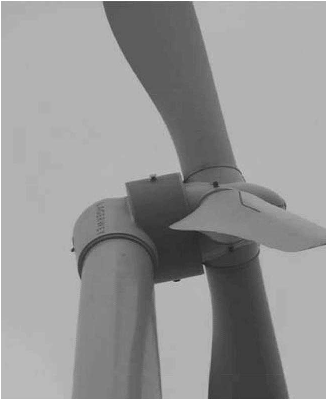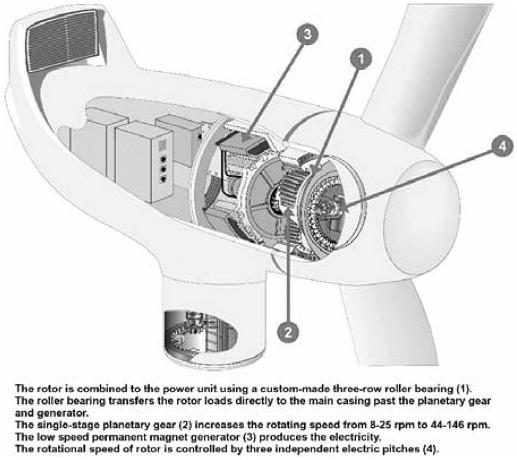




Did you find this useful? Give us your feedback













![Fig. 5. IEEE recommended equivalent circuit of the induction machine and the applied Γ-type equivalent circuit [15].](/figures/fig-5-ieee-recommended-equivalent-circuit-of-the-induction-3kn1363z.png)







2,465 citations
1,023 citations
...1 Performance comparison of different wind generator systems Some comparisons of different wind generator system have been conducted by some researchers [8–13, 17, 19, 24, 26, 39–41]....
[...]
...Additionally, a variety of innovative concepts of wind turbines appear, for example, an interesting alternative may be a mixed solution with a gearbox and a smaller low speed permanent magnet synchronous generator (PMSG) [7–9], because direct-drive wind generators are becoming larger and even more expensive for increasing power levels and decreasing rotor speeds....
[...]
...3 Discussions of comparison criteria Various criteria may be used for comparing different wind generator systems, including the torque density, the cost per torque, the efficiency, the active material weight, the outer diameter, the total length, the total volume, the total generator cost, the annual energy yield, the energy yield per cost, the cost of energy and so on [8, 9, 12, 13, 16, 17, 21, 25]....
[...]
...[9] have also presented a detailed comparison of five 3 MW different generator systems for variable speed wind turbine concepts, which are a DFIG system with three-stage gearbox (DFIG 3G), a direct-...
[...]
...† DFIG 3G is the lightest and low-cost solution with standard components according to [9]....
[...]
860 citations
797 citations
...3b compares the direct driven (DD) synchronous generator (SG) with the 3 stage gearbox (3G) Doubly-Fed Induction Generator (DFIG), using the latter as the base value for both weight and losses [8]-[9]....
[...]
694 citations
...tear, reduced life span, reduced efficiency and need for regular maintenance [30], [50]....
[...]
...5 times heavier compared to the three-stage gearbox based induction generators [50], [54]....
[...]
277 citations
242 citations
...where ls is the stack length in axial direction, rs is the stator radius, Ns is the number of turns of the phase winding, kw is the winding factor [14], [15], p is the number of pole pairs, and geff is the effective air gap....
[...]
...The no-load (motional) voltage induced by this flux density in a stator winding can be calculated as [15], [16]...
[...]
...The magnetizing inductance of an AC machine is given by [14], [15]...
[...]
...Using Fourier analysis, the fundamental space harmonic of this flux density can be calculated as [15], [16]...
[...]
...The parameters of the second equivalent circuit can be calculated from the parameters of the first in the following way [15]:...
[...]
185 citations
...The model used here divides them into three parts [13]: 1) a small part that is constant and consists of power dissipated in power supplies, gate drivers, control, cooling systems and so on [9]; 2) a large part that is proportional to the current and consists of switching losses and conduction losses; 3) a part that is proportional to the current squared and con-...
[...]
...The machine parameters are calculated in conventional ways [9]....
[...]
154 citations
...However, [3]–[7] claim benefits for permanent magnet excitation, which elim-...
[...]
...the cost of the permanent magnets and the power electronics is decreasing and because further optimization and integration of the generator system is possible [3], [18], [19]....
[...]
Very important design aspects for which further work is needed are reliability and availability [ 20 ].
The phasecurrent is in the middle between the terminal voltage and the voltage induced by the magnets in order to reduce the saturation and to get a compromise between the converter rating and the generator rating.
The phase current leads the phase voltage a little in order to reduce saturation and excitation losses while a larger rating of the converter is not necessary.
Manufacturers supplying the DFIG3G use generator and converter components which are close to industrial standards yielding benefits in standardization, cost, and reliability.
With a gear ratio of 80, the rated speed of the generator is 1200 r/min, so that at rated speed, there is still some margin for control purposes.
The parameters of the second equivalent circuit can be calculated from the parameters of the first in the following way [15]:Ls = Lsσ + Lsm;RR = RrL2 sL2smLL = LsσLs Lsm + LrσL2 sL2sm . (15)To simplify the calculations, the second equivalent circuit has been used.
Using these characteristics, the available shaft power P can be calculated as a function of the wind speed as [2], [10]P = 1 2 ρairCp(λ, θ)πr2v3w (1)where ρair is the mass density of air, r is the wind turbine rotor radius, vw is the wind speed, and Cp(λ, θ) is the power coefficient or the aerodynamic efficiency, which is a function of the tip speed ratio λ (tip speed divided by wind speed) and the pitch angle θ.
The only commercially successful large direct-drive wind turbine manufacturer, Enercon, uses this system but they claim other benefits from the system.
The losses in the gearbox dominate the losses in this generator system: Roughly 70% of the annual energy dissipation in the generator system is in the gearbox.
The factor representing the reluctance of the iron of the magnetic circuit is calculated as [17]ksat = 1 + 1Hggeff ∫ lFe 0 HFedlFe (7)where HFe is the magnetic field intensity in the iron, estimated from the BH curve.
Because it is mainly built from standard components consisting of copper and iron, major improvements in performance or cost reductions cannot be expected.
The magnetizing current of this induction machine is rather large due to the considerable air gap and the high number of pole pairs.
Because the paper concentrates on the generator system, these numbers are not extensively validated and must be seen only as indicators.
In permanent-magnet machines, this factor representing saturation is much smaller than in the other machines because the effective air gap is much larger due to the low permeability of the magnets.
The annual energydissipation, determined from a combination of the losses with the Weibull distribution, is also depicted in Fig.
The annual energy dissipation, determined from a combination of the losses with the Weibull distribution, is also depicted in Fig. 13.
Iron losses are not negligible; at wind speeds up to 8 m/s, they are larger than the copper losses and over 15% of the annual dissipation in the generator system is in the iron.